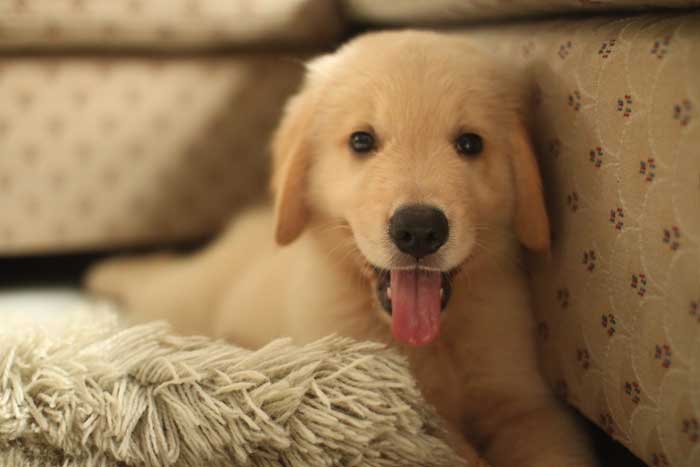Sometimes life decisions mean that you will find yourself moving into an apartment. Other times, you might be used to living in an apartment but want to introduce a new four-legged friend into the family.
No matter the reason, there are a lot of things that you will have to do to prepare a puppy for life in an apartment.
After all, apartments are vastly different than typical houses, meaning that there will be a lot of changes that you have to make to ensure a puppy is safe, comfortable and happy.
Preparing yourself and the apartment before the arrival of your puppy will make it easier for him to cope with his new environment, as well as boost your relationship and your time together.
When Should You Bring a Puppy Home?
There is no simple straightforward answer to this question, but socialization is the biggest factor that determines whether a puppy is ready to leave his breeder, siblings, mother or litter-mates to live with his new family.
A puppy’s basic socialization process begins at 3 to 14 weeks. During this phase, the little one learns to be a dog and to interact with other dogs or humans, depending on his immediate environment.
The skills learned during this stage will impact his social and behavioral traits even in his adulthood.
Most experts recommend picking your puppy from the breeder at 8 weeks. At this age, he has had enough interactions with his mother or playmates and the skills learned will help him survive as a dog away from his initial family.
The pup is also capable of accepting a new family at this age since he is not too attached to his playmates or relatives at this point.
What You Need Before Getting a Puppy
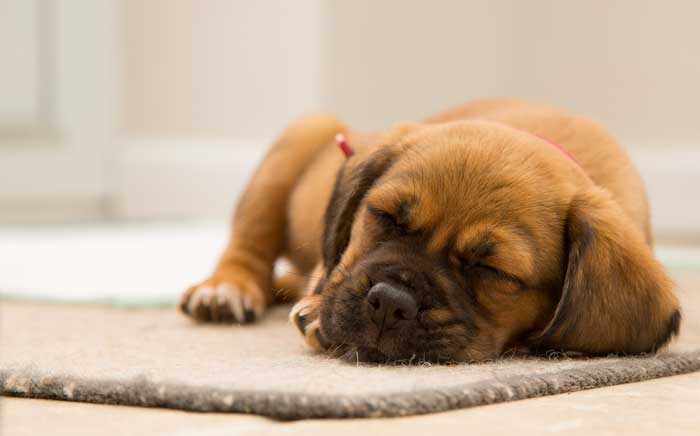
It’s just like getting a baby, preparations start way before the puppy comes home. You need to educate yourself on a number of puppy related issues.
First, you’ll have to familiarize yourself with the puppy’s growth stages and what to expect during each stage. You’ll also have to understand common puppy diseases, their symptoms and when to take him to the vet.
Lastly, it is important to seek education on how to train your puppy to be obedient and receptive to your commands.
A puppy will also come with needs and expectations and there are certain things you should purchase in preparation for his arrival. Below is a simple checklist:
1. Puppy Food and Treats
While you may feed him the same food you’re eating, it is advisable to invest in proper puppy food. A puppy’s survival rate can be compromised if he is not fed well.
Remember, the puppy is still in his early stages and he may not be able to handle certain foods, like a grown dog.
Treats, on the other hand, come in handy when you’re training him to obey commands. Rewarding your puppy whenever he does the right thing can be very motivational. This will encourage him to do better in future.
2. A Dog Crate
A dog crate is a replica of a dog’s kennel, only that it can be used indoors, especially in an apartment.
This kind of dog housing will be necessary when you’re leaving him in the house all by himself, It will cage him but also give him enough room to play around, as well as eat and sleep.
3. A Dog Bed
A dog bed is a must-have as your puppy cannot afford to sleep on the floor or on the couch. A designated bed will be his safe haven where he retreats whenever he needs some alone time.
4. Puppy Eating and Drinking Dishes.
With their canine teeth and their tendency to link cups and plates. you will need special dog dishes.
Melamine works perfectly and it can be washed with ease. Melamine plates and cups do not harbor dirt and they’re not likely to break and harm the puppy like glass.
5. Toys
Teething is one for the most prominent puppy stages you’ll have to deal with. Also known as the chewing stage, this phase can be destructive, especially if he begins to chew all the wrong things, like your food, cosmetics and plants.
This is why you need special puppy toys to keep him busy and distracted in the right ways. Puppy toys are safer and they’re less likely to cause health problems, as long as you clean them regularly.
6. A Blanket
Puppies may have fur but they also get cold, especially during cold weather seasons. You’ll need a blanket to keep him warm and comfortable when the rains or winter come pouring down.
7. Grooming Utilities
Talk to the vet or the pet store owner to establish which utilities are effective for the breed you intend to get. Different breeds have different fur textures and sizes.
You, therefore, need the right brush and shampoo to prevent parasites from breeding inside the pup’s body. As you shop for grooming utilities, bear in mind that puppy parasites can easily cause premature puppy death if left untreated.
8. Baby Gates
A baby gate it will help you contain the puppy, especially when you’re not in the house or when you’re asleep. Puppies are eager to explore new environments and they may walk into the kitchen or bathroom and damage things or get hurt.
Other times, when they feel lonely, they will try to escape. This is why you need to buy baby gates to restrict them from unsafe spaces within the apartment.
9. A Leash and Collar
These two items will come in handy when you begin to take walks in the park or simply stroll within the neighborhood.
They’ll make it easier to keep the puppy controlled at an arm’s length thus preventing them from outrunning you.
10. Identification
Sometimes puppies run away and it can be difficult to find them if the only identification is their fur color. You might want to put some form of identification on his collar to make it easy for strangers to identify him and bring him back home in case he gets lost.
Attaching an identification card with his name and your contact info would be an excellent idea.
What Is the Largest Difference Between Apartments and Houses?
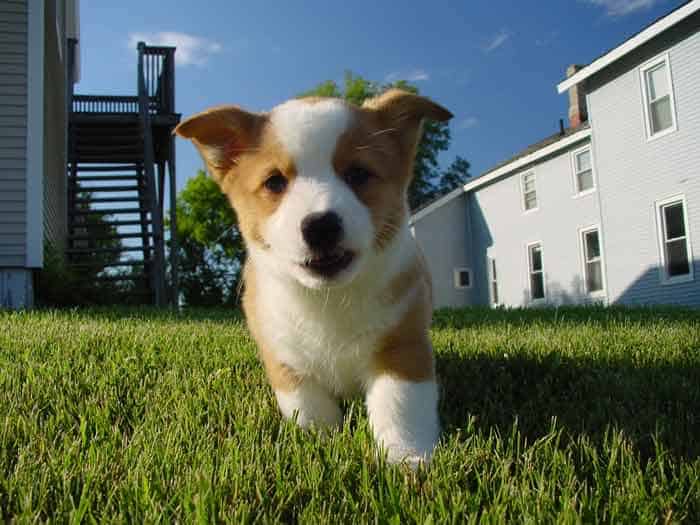
When it comes to differences between apartments and other types of homes, there is one glaring difference that can mean a lot when it comes to raising a dog.
Apartments, at least most of them, do not have much access to an outdoor area where your dog can freely eliminate waste as it needs to. This can make life quite a bit different, both in terms of house-training your puppy and taking care of it when it does need to go.
Depending on your situation, there are a few changes you can make to ensure that this will be as easy as possible for you and your puppy.
If you can, you should try and make sure that you can get an apartment on the first floor of the building. Puppies, for the first month after their birth, physically cannot hold themselves from peeing for an hour. This means that you will at minimum have to take your dog to pee at least once an hour.
It goes without saying that this task is more easily done when you are on the first floor of an apartment complex.
However, there are options to make it easier for your dog to urinate and defecate without him disturbing you or anyone else on your floor.
How Do You Make Sure That Your Dog Has a Place to Pee?
When you are trying to figure out how to prepare for a puppy in an apartment, arguably one of the most important things that you can do is make sure that it has a place to eliminate.
If you cannot get a place on the first floor, then there are a few other options to consider.
First, you will always want to set aside some extra money. Puppies are going to have accidents; no matter how well you train him and how well you keep an eye on him, it is inevitably going to happen at least a few times.
Having some extra money to take care of stains is important and being able to take care of an accident when it happens will leave a better impression on your landlord.
Next, if you cannot get a place on the first floor, you should look for apartments that have balconies.
You can then use that extra balcony as an emergency bathroom for your dog, especially in the first month when you might not want to risk going down an elevator holding a dog that is unable to control its bladder.
Using some grass pads for your balcony will significantly reduce stress on your end and it will give your puppy a place where he can comfortably pee if he needs to.
It is also important that you establish a routine for going to the bathroom from an early age.
Because apartments don’t really have yards and backdoors that you can simply let your dog out of when the urge strikes, you will have to make sure that you establish a schedule so that you and your puppy know when it is time to go.
This will take some time but it will be worth it in the end because your puppy will also know that it will be let out at some point to relieve himself.
How Will You Keep Your Apartment Safe?
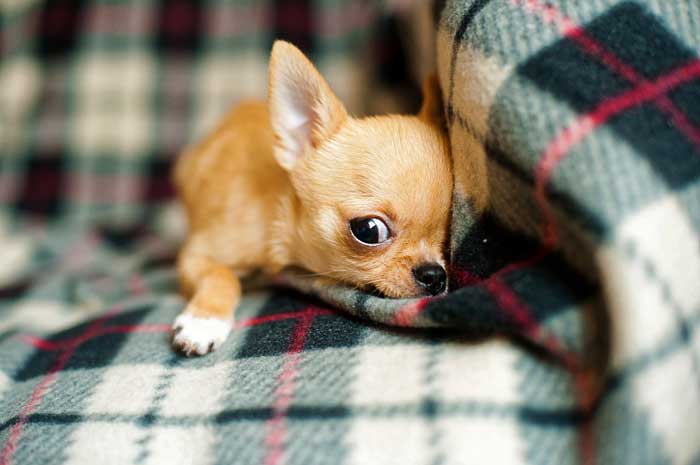
While it is not nearly as pronounced as it is with cats, dogs also have claws. Dogs and puppies also have teeth that they will use to more or less chew on anything they can get their mouth on.
Until your puppy has grown out of the phase where it wants to put everything in its mouth, you will want to make sure that you keep everything you don’t want your dog to chew on out of range.
For furniture, consider buying covers and protectors that will lessen the damage that your puppy can do.
Of course, if you notice that your puppy is repeatedly chewing on furniture, you will want to consider talking to a behavioralist about finding a way to stop that behavior. With that being said, it is never a bad idea to have protectors for your furniture.
As for the floor of your apartment, you will want to invest in rugs — a lot of rugs. These rugs will prevent your floor from being scratched at by your dog’s claws and it will be a lot more comfortable for your puppy than declawing or putting something on its feet.
In fact, you can even find a way to make personality and color to your apartment by being able to choose rugs that have nice designs or colors.
To make sure that your puppy has a designated play area where it knows that it is okay to chew on things, you might want to set aside a space or an entire room for your puppy to have its toys, bones, and other chew toys.
By making sure that your puppy has a designated area to play, you can minimize the damage that can occur when your puppy gets overly playful and starts chewing on everything in sight.
After all, it is cheaper to pay for repairs in one area of your apartment than paying for repairs throughout your entire apartment.
How to Puppy Proof Your Apartment
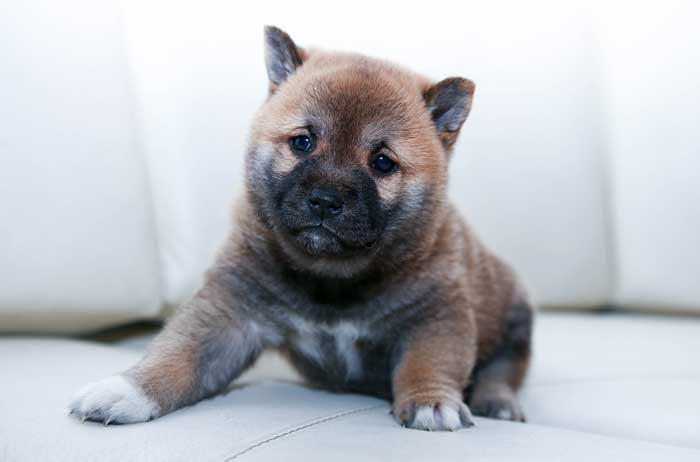
To prepare for the new puppy, you will need to puppy proof your apartment in order to make it safe enough for the pup. Some precautions that we can take are:
1. Lock up Cosmetics and Cover Your Trash
The first step should be getting rid of anything that could cause health risks. Keep all your medicine, cosmetics and food substances locked up or out of their reach.
In addition, cover your trash or keep it out of their sight. To puppies, smells coming from a trash can or a ‘strange bottle’ spark their curiosity, They will want to explore and find interesting things to chew on or eat.
2. Keep Electric Cords and Chargers Away
Your puppy will definitely want to chew and lick power cables and cords. Chewing on an electric cable which is still connected to the power source can be hazardous if it causes electrocution. To prevent this from happening, simply store away such cables and electric devices after using them.
You may also use baby gates to keep the pup away from wet areas (near sinks) if you’re using electric devices such as a curling iron in the bathroom or a coffee maker in the kitchen, as he could easily pull cables when you’re not watching, and end up causing serious problems.
3. Lock the Toilet
The toilet is another area that needs to be puppy-proofed. Dogs get the urge to drink water from the toilet bowl.
This is unsafe for both you and the puppy. You, therefore, need to ensure your toilet has a lockable door. Also, ensure the toilet bowl is constantly covered just in case you forget to lock the door.
4. Get Rid of Poisonous House Plants
House plants are also perceived as potential health hazards for puppies, You may need to research on plants and establish whether the ones in your house are poisonous to puppies.
If you have any poisonous plants, find a way to ensure your puppy does not get into contact with them.
How to Puppy Proof Your Balcony
The balcony also poses a number of threats to your puppy. He could easily fall from this area or use it as an escape route, hence the need to puppy proof it as well.
1. Get rid of furniture
Chairs and tables form perfect stepping ladders if the puppy intends to escape. Getting rid of furniture will eliminate the puppy’s chances of running away or falling hard from the top of a balcony.
2. Ensure your back door is lockable
If you’re dealing with a clever breed, he may trace his way to the balcony through the back door when you’re not watching.
Remember, dogs are excellent at cramming direction. Therefore ensure the back door (if it leads to a balcony) is lockable before bringing the pup home.
3. Rail Safety
To prevent the pup from squeezing through balcony rails or grills, you may need to take safety measures.
Installing safety nets or chicken wire in a balcony can create a strong barrier without compromising the view or the fresh.
However, some pups can easily chew through the netting. In such instances, plastic or glass Plexi panels will do a better job.
4. Repaint the grills
If your balcony grills are metallic and black in color, they’re likely to absorb heat and burn the delicate pup whenever he leans on them. To prevent this from happening, repaint them to white, to prevent excessive heat absorption.
How Do You Make Sure Your Puppy Gets Exercise?
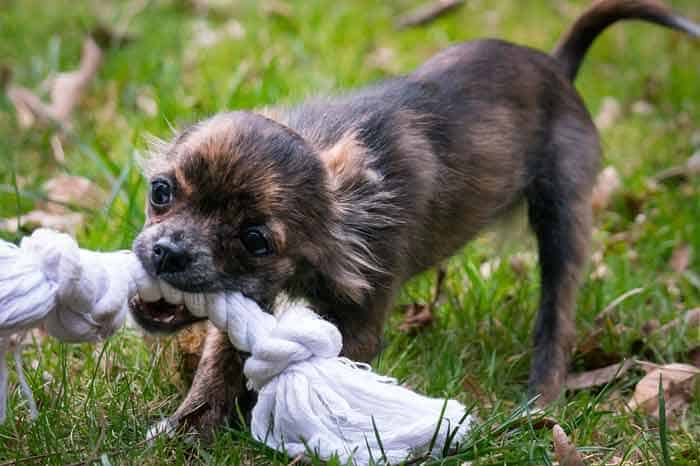
Last but not least, puppies and dogs need exercise in their lives. This means that you will have to accommodate for that when you are living in an apartment complex.
Taking long walks around the city is usually the best way to take care of your puppy’s relentless energy but there will eventually come a time when you cannot take your puppy outside for one reason or another.
If you have already established a play space for your puppy, you can consider using that area for this.
Otherwise, if you have a hallway in your apartment, you should use that area and make sure that there are protective mats and rugs to ensure that your puppy isn’t scratching the floor up.
Once you have found a suitable place you will want to rile your dog up a bit, having him run up and down the hallway or to one side and then the other of its play space. Eventually, this will drain the endless well of your puppy’s energy and you won’t have to worry about him beginning to freak out that he hasn’t been taken on a walk yet.
You could also consider getting some toys designed for tugging so you can tucker your puppy out that way.
If possible, you can also look for the nearest dog park. If you plan on taking your puppy to a dog park regularly, you will want to make sure that your puppy is vaccinated and that the dog park has an area for puppies to play.
You will also want to make sure that your puppy is able to properly socialize with other dogs as nobody wants anything bad to happen to their dogs.
While you might not need it immediately, you should also consider looking into dog sitters and dog walkers who are nearby and who you would trust to take care of your puppy.
You never know what type of situation might occur, putting you in a position where you need someone to take care of your puppy and take him out for walks.
Having one of these people in your contacts can help make sure that your puppy is able to get his exercise no matter what happens.
How Do You Welcome the New Puppy Home?
Moving into an apartment can pose a lot of new scents, sounds, and sights for a puppy. In fact, it can quickly become far more overwhelming than interesting if your puppy is not used to an urban environment.
The best way to ensure that your puppy doesn’t become terrified is to make sure that your puppy is desensitized to an urban environment.
Assuming that you can, you should try and take your puppy for walks around town. However, you should also make sure that your puppy is properly vaccinated before you do this as you will want to keep it as healthy as possible.
Once inside the apartment, you might want to talk to your neighbors about letting your puppy meet them. Having more people that your puppy is at least a little bit familiarized with ensures that your puppy will have fewer things to stress and fear.
The last thing that you need when you are moving a puppy to an apartment is to stress him out.
Give him a tour of the apartment. Your new friend will grow accustomed to his new environment faster if he is familiar with it. Moreover, a tour of the house will make him feel welcome rather than restricted to the living room.
If you have other family members or pets take precaution when introducing him. Do not allow other people to carry or pet him as this may overwhelm him.
If you’re living with a cat or another pet, refrain from introducing them to each other at first, as this may cause friction and confusion.
Spend the first day with him. Do not leave the pet at home in a crate all by himself on the first day. Spend time studying his behavior patterns and socializing. This will prevent him from feeling isolated, as well as help in creating rapport.
Make use of treats during the first few days. Treats will make the pup feel special and loved. Moreover, he will associate you and his new environment with goodies and rewards, thus compelling him to form a bond with you.
Most importantly, take time to play and walk with him. The ultimate goal is to build a connection and to inform him that you are his new friend.
While helping the puppy adjust to his new environment, ensure you establish a routine. This will make it easy for him to interpret and adjust to everything.
Final Thoughts
There are a lot of things that you can do to prepare your apartment for a brand-new puppy.
From making sure that you have a place where your puppy can eliminate its waste to having a plan to what you can do when you cannot walk your dog yourself, there are a lot of things to take care of.
However, with enough diligence and time, you will have an apartment that is ready for your puppy to come home to.

